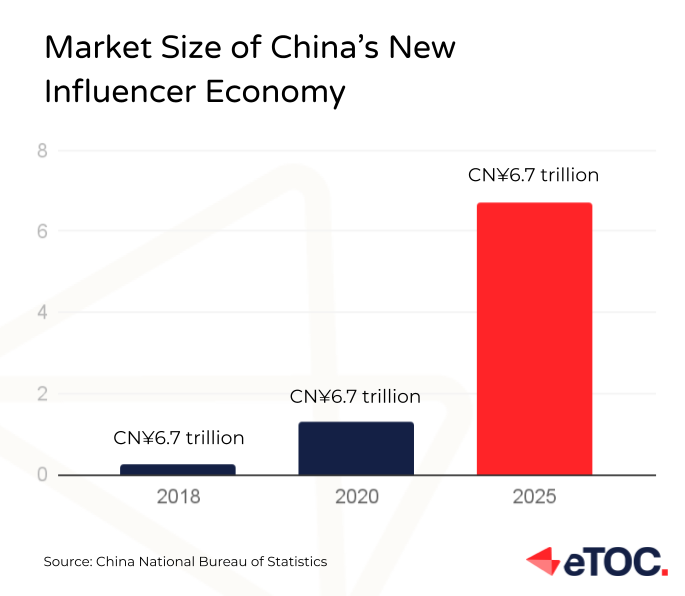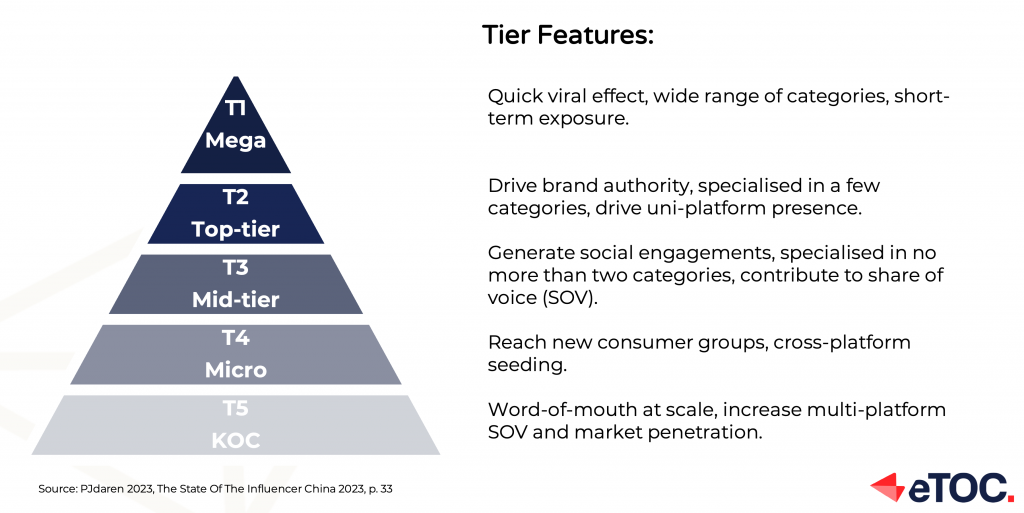The Rising Power of KOCs, Micro-KOLs and Mid-Tier KOLs in Chinese Influencer Marketing
China’s influencer marketing industry has emerged as a global trailblazer, revolutionizing the way brands connect with consumers. With its seamless integration of social media, e-commerce and mobile payments, the Chinese KOL and KOC economy has experienced unprecedented growth in recent years. The COVID-19 pandemic and preventive measures further accelerated this growth, as Chinese consumers spent an average of over seven hours daily on the internet, seeking information and guidance through social media, influencers and friends for their purchase decisions. The result? China’s influencer economy bloomed from CN¥241.9 billion in 2018 to CN¥1.3 trillion in 2020, with a projected market size of CN¥6.7 trillion by 2025.

A Shift in Focus: Embracing KOCs, Micro-KOLs, and Mid-Tier KOLs
The year 2022 ushered in a new wave of influencers, as Chinese brands strategically refocused their influencer marketing efforts. Rather than solely relying on celebrities and top-tier KOLs, brands are now turning to authentic, high-quality mid-tier KOLs and KOCs. This shift stems from a desire to optimize influencer communications’ efficacy and accurately measure the impact of marketing campaigns. The trend has prompted platforms to bolster content management capabilities and provide valuable resources to support emerging KOLs and KOCs, catering to the growing demand for high-quality and diverse content.

Understanding Different Tiers of KOLs and KOCs
Influencer marketing serves as a crucial bridge for brand activations, effectively driving exposure, conversion and overall success. Influential KOLs and KOCs play a pivotal role in generating brand awareness, establishing authority and driving web traffic, ultimately leading to increased sales volume for businesses. From the consumer’s viewpoint, influencer marketing holds immense value, shaping perceptions, deepening connections and expanding their understanding of products and services.
In China, influencer marketing is characterized by distinct tiers of influencers, each playing specialized roles in achieving various marketing objectives:
- Mega and top-tier KOLs excel at enhancing exposure through quick viral effects, making them ideal for large-scale campaigns that require significant visibility and brand awareness. These influencers often have massive followings on platforms like Weibo and WeChat, allowing them to reach a vast audience in a short period.
- Mid-tier KOLs are more effective in short-term sales conversion and generating social engagements. They tend to have a more engaged and loyal following within specific niches or industries, allowing brands to create targeted and impactful campaigns. This makes mid-tier KOLs valuable for product launches, promotions and driving immediate sales.
- Micro-KOLs and KOCs are pivotal for building word-of-mouth at scale and cross-platform awareness, reaching new consumer groups and driving sustainable brand growth. Although they may have a smaller but highly engaged audience, their word-of-mouth influence holds significant power in increasing multi-platform share-of-voice and market penetration.
The effectiveness of influencer marketing lies in strategically utilizing different influencer tiers across platforms. By combining influencers from various tiers, brands can expand their reach, build trust and generate meaningful engagements with their target audience, leading to a successful and impactful influencer marketing strategy.

Reasons for the Shift from KOLs to KOCs, Micro-KOLs, and Mid-Tier KOLs
Several factors have contributed to the rising popularity of KOCs, Micro-KOLs and Mid-Tier KOLs in Chinese influencer marketing:
- Cost-Effectiveness: The high costs associated with collaborating with famous KOLs have driven brands to seek more cost-effective alternatives. KOCs and Micro-KOLs offer attractive rates and the potential for higher ROI due to their authentic and targeted approach.
- Risk decentralization: Recent scandals, like tax evasions etc., involving celebrity KOLs have led to a decline in trust among consumers. Besides, the Chinese government has tightened regulations on influencer marketing and taxation, leading to increased scrutiny on top-tier KOLs. This has incentivized brands to turn to KOCs and Micro-KOLs to mitigate potential risks associated with influencer collaborations.
- Authenticity and Relatability: Chinese consumers, especially millennials and Generation Z, crave authenticity and relatability in influencer content. KOCs and Micro-KOLs are seen as authentic product advocates rather than celebrities promoting products. Their reviews and endorsements carry more weight, influencing consumers’ purchasing decisions.
- Niche Audience Engagement: As the market is more segmented and different industries have unique preferences and goals when developing influencer marketing campaigns. Collaborating with KOCs and Micro-KOLs allows brands to effectively engage niche audiences and reach accurate core target audiences to maximize the impact of their campaigns.
- Diverse Content: Brands are increasingly recognizing the value of diverse and tailored content that speaks to various consumer segments. Partnering with KOCs and Micro-KOLs enables brands to create more personalized and relevant content and better communicate with their specific audiences.
Tailoring Influencer Marketing Campaigns for Different Industries
Different industries have their unique preferences and goals when developing influencer marketing campaigns. For the automobile, luxury, and parenting sectors, the primary focus is on strengthening brand image and launching new products. Influencers in these categories leverage their authority and expertise to provide valuable insights and recommendations, significantly influencing consumers’ purchase decisions. On the other hand, beauty & personal care, F&B, 3C and home appliances industries emphasize regular content seeding, promoting new products, sales events and offline activations. By collaborating with KOCs, Micro-KOLs, and Mid-Tier KOLs brands can effectively engage niche audiences, maximizing the impact of their campaigns.
In summary
The Chinese influencer marketing landscape is witnessing a profound shift as brands embrace KOCs, Micro-KOLs, and Mid-Tier KOLs in their marketing strategies. The rise of these influencers is driven by their cost-effectiveness, authenticity, and ability to engage niche audiences effectively. As influencer marketing continues to evolve, brands must embrace this shift and leverage lower-tier KOLs and KOCs to reach their accurate core consumers and communicate with them via diversed and authentic content. Thus, brands can engage more loyalty consumers, generate more sales and secure a successful and impactful presence in the dynamic Chinese market. As the influencer economy continues to thrive, the future holds promise for continued growth and innovation in Chinese influencer marketing.

Discover the Future of Shopping with "Shopatainment – The Future of Shopping"
Our new book “Shopatainment – The Future of Shopping” explores how the innovative fusion of shopping and entertainment is revolutionizing the way we shop. Learn about the origins of this trend in China, the technologies and formats being used, and the opportunities and challenges it presents for the West.

Want to expand to the Chinese market? Contact us for a first free consultation.
